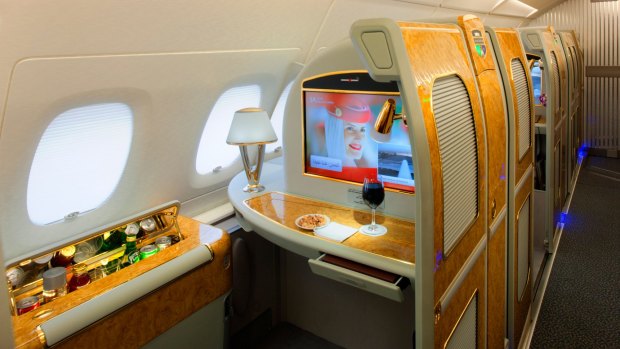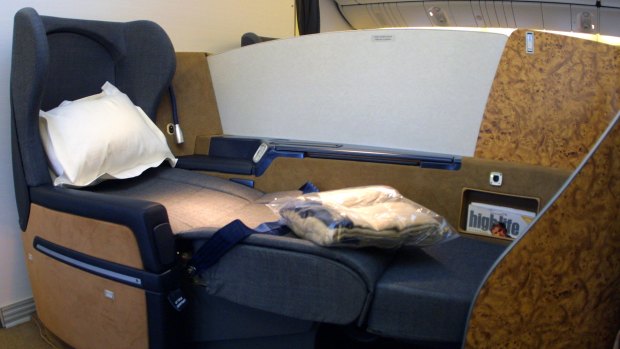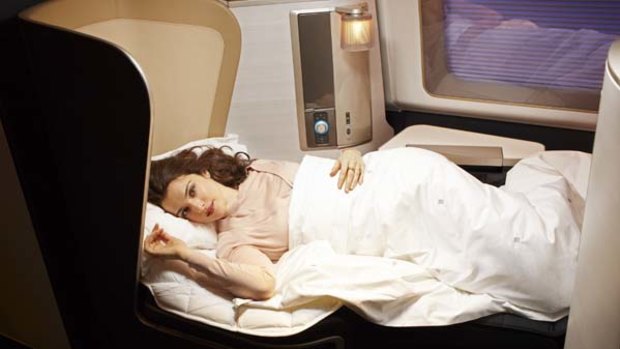This was published 6 years ago
First class airline seats versus business class: Why flying first class is out of favour
By Michael Gebicki
"A light was upon it for which his language had no name… He saw no colour but those he knew, gold and white and blue and green, but they were fresh and poignant, as if he had at that moment first perceived them and made for them names new and wonderful. In winter here no heart could mourn for summer or for spring."
That's Frodo describing his first view of Lorien in Tolkien's Lord of the Rings, and his words could also apply to a real-life Shangri-la where few of us will ever tread. It's called the first-class cabin.
First-class air travel first appeared in the 1950s, and while it's evolved into a no-holds-barred luxury experience, first class is a threatened species. Only a small number of the world's airlines offer a first-class service these days.
First-class cabins are more likely to be found on wide-bodied aircraft, with the Airbus A380 as the airlines' favourite for the spruce-up treatment. As some of the world's longest-haul flyers, Australians get a fair choice of carriers with first-class cabins. According to Seatguru, Singapore Airlines has 12 closed first-class suites on its A380s, Emirates has 14 and Qantas has the same number, although these are open suites. Etihad has nine first-class seats on its A380s, 12 on its A340s. Qatar has up to 12 on some of its A330s.
There are also some notable omissions from the list of first-class carriers, such as Virgin Australia, although it does offer a much-lauded business class on the three-class Boeing 777-300ER aircraft between Australia and Los Angeles, as well as aboard its two-class Airbus A330-200 flying between Melbourne and Hong Kong. According to a Qantas spokesperson, the new Boeing 787-9 Dreamliner that the airline will operate on its Perth-London non-stop flight, set to commence in 2018, will not have a first-class cabin.
See also: Qantas' non-stop Perth to London flights go on sale

The Emirates A380-800 first class private suite.
In the main, demand for first-class seating is limited to senior executives flying long haul between major commercial centres, with a sprinkling of megastars, top-level sports stars and the occasional royal. Middle Eastern carriers draw many of their first-class clients from the wealthy ruling elite of the Gulf states.
A seat in the first-class cabin costs roughly double the price of business class. A round-trip ticket from Melbourne to London flying with Qantas or Emirates in April 2018 will set you back almost $16,000, and about $2500 less aboard Singapore Airlines.
That price differential is part of the reason for the decline of first class, but far more potent has been the blurring of the lines that divide first class from business. Business class has upped its game to the point where first class of two decades ago would be a pale shadow of today's business class. British Airways was the first to install a lie-flat seat in first-class cabins, in 1995, but on any premium carrier these days you can expect a lie-flat seat in business.

Credit: Getty Images
Privacy screens, now a feature of leading business-class cabins, were unknown in first class 20 years ago. Other features that were once the exclusive preserve of first-class travel such as wide-screen inflight entertainment systems and noise-cancelling headphones have migrated to business class.

Sign up for the Traveller Deals newsletter
Get exclusive travel deals delivered straight to your inbox. Sign up now.